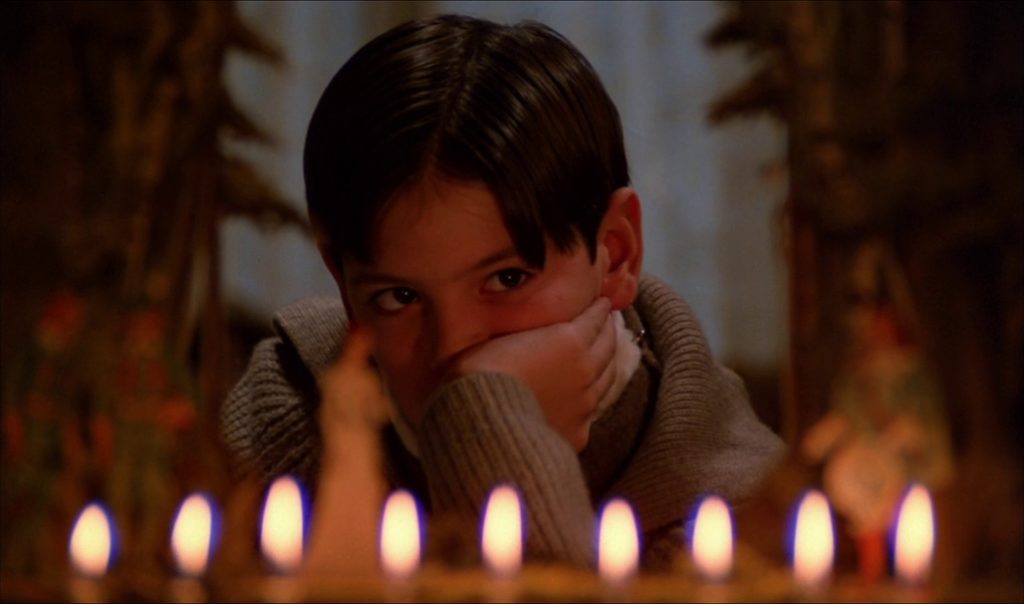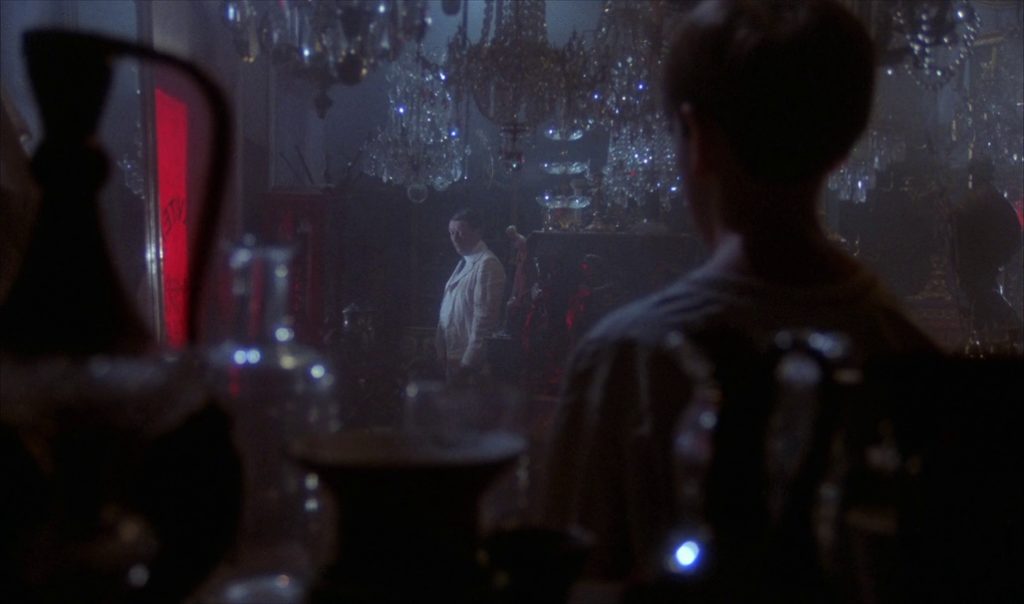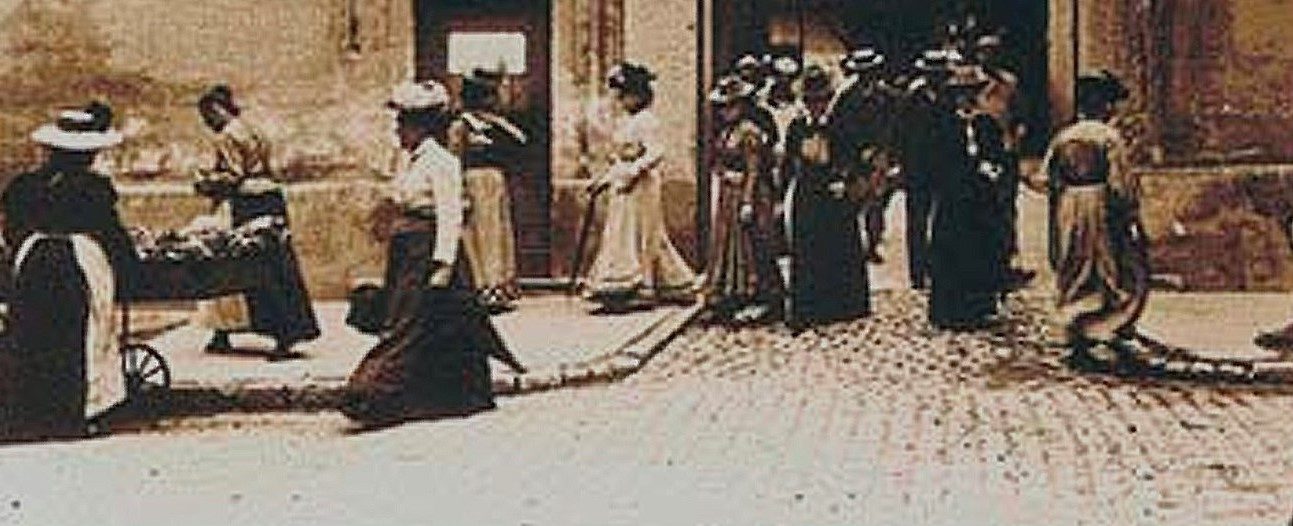Sweden, France, (West) Germany, 1982
Directed by Ingmar Bergman
With Bertil Guve (Alexander Ekdahl), Pernilla Allwin (Fanny Ekdahl), Gunn Wållgren (Helena Ekdahl), Allan Edwall (Oscar Ekdahl), Ewa Fröling (Emilie Ekdahl), Jarl Kulle (Gustav Adolph Ekdahl), Börje Ahlstedt (Carl Ekdahl), Jan Malmsjö (Bishop Edvard Vergerus), Erland Josephson (Isak Jacobson), Mats Bergman (Aron Retzinsky), Stina Ekblad (Ismael Retzinsky), Pernilla August (Maj)

First a stage director, a job that would keep him busy over a long part of his life, Ingmar Bergman becomes a movie director in 1945, age 27. He gets interested in television in 1969 and in 1973 he shoots a kind of hybrid production: “Scener ur ett äktenskap – Scenes from a Marriage”, a study of an upper-middle class couple grappling with a crisis sparked off by the husband’s infidelity that is edited in two formats, a six-part series for the small screen and a feature of a shorter running time for the big screen. In the wake of the work’s success, Bergman spends more time working for television than for cinema – and also more time outside his native Sweden, after being involved in a fiscal scandal.
“Fanny och Alexander” is the same kind of production than “Scener ur ett äktenskap”. Marking the coming home of the prodigal son, the project quickly evolves into the biggest and costliest venture in the history of Swedish cinema at that time. A first theatrical release, lasting three hours and eight minutes, is shown in 1982; the following year the huge material Bergman shot (24 hours of rushes) is turned into a series for the national public broadcaster (which has been one of the producers). This far longer version has always pleased the director far more than the movie which he deemed too short to reflect fully his intent and the quality of his work. Over a quarter of century later, the film is digitally restored and a new theatrical release, lasting some five hours and twenty minutes is made available, doing justice to Bergman’s last genuine work for cinema (though he later shot other works for television).
Taking place in Uppsala, his native town, the narrative is composed, like a traditional novel or play, in four acts with a prologue and an epilogue, with the same urge for efficiency and elegance. It follows over a short time the lives of a brother and a sister, both children, though the boy, who is the eldest, is reaching adolescence at the end. They belong to an extended family, the Ekdahls, whose life is connected to the local theater. But the death of their father is followed by the surprising decision of their mother to get remarried with a suave but stern and strong-minded Lutheran bishop. The marriage becomes a nightmare for the kids and ends in tragedy for the husband; eventually, Fanny, Alexander and their mother Emilie move back to where they once, happily, belonged.
Rituals cleverly define how the world where Fanny and Alexander were born is warm, cheerful and lively. The long first act depicts the traditional Christmas meal and evening the Ekdahls spend together in their town house around the family’s matriarch, former actress and widow Helena. Her three sons present an interesting range of emotions and situations: Oscar, also an actor and manager of the theater the family owns, husband of Emilie and father of Fanny and Alexander, is a kind and gracious middle-aged fellow whose health looks frail; Gustav Adolph is a businessman (and it seems that trade and money must have play a big part in these lives to explain the lavish and bourgeois lifestyle of the Ekdahls) who is also married, with three children, and above all is expansive, eccentric and excitable, always quick to ogle young and beautiful women, especially one of Helena’s maids, Maj; and Carl is the herd’s black sheep, a scholar who does not hold his liquor but holds too much debts and moreover despises his German-born wife precisely because she keeps loving him through thick and thin. The director, in a remarkably fluid and definitely masterful manner, segues one funny anecdote into a sadder one and a tense moment into a magical one ceaselessly to build the moving portrait of singular individuals and the endearing ensemble they form, a little community cemented by the obvious pleasure for life and earthly things.
The epilogue mirrors the warm and joyful tone of the first act. The Ekdahls, who have demonstrated the strength of their sentiments and the sense of duty it imposes during the second ritual shot by the film, the one that abruptly changes the lives of Fanny and Alexander, that is, Oscar’s funeral, are gathering to celebrate the baptisms of Emilie’s new daughter and the baby girl born from the affair between Maj and Gustave Adolph. The businessman makes a rambling speech that may amuse but that essentially claims the family’s identity as people dearly attached to this pleasures derived from life and earthy things. This the celebration of la joie de vivre and of people’s abilities to navigate around challenges and towards life’s rewards and pleasures; this is about dropping the curtain on the tragic mistake Emilie made; and this is the vindication of art and hope over religious and moralistic tenets.
Tellingly, apart from his wedding to Emilie, no rituals define the life of Bishop Edvard Vergerus – even if performing rituals is part of his job. The ordeal he inflicts on Emilie, Fanny and Alexander during the third and fourth acts takes place in his official residence, a grim house with white walls and dark doors and furniture, the perfect opposite to the Ekdahl mansion, a depressing and stifling world ruled by his wicked sister and mother, with an acute sense of proprieties and social ranks – for these people, the custom of sharing the Christmas feast with the maids or the quiet acceptance of the consequences of a man’s sexual drive, elements that are so surprising and moving in the film’s first part, would surely be a scandal and proof evil is on Earth; but who is the worst: the people embracing life’s complexities or the man who use love to fulfill his own vanity?

Inside these drab settings, the story becomes the increasingly violent confrontation between Vergerus and Alexander, who hates the bishop from the start; it widens into the desperate struggle of Emilie to break free from a trap of her own making; it ends with a conflagration that cruelly does not bring the sort of purification Vergerus is always contemplating and imposing by force (he would explain that his love is naturally harsh and fierce) but the destruction of his hypocritical and devious life. Religion, and the moral standards that come with it, is cast as false hope and a betrayal of life, which does call for sincere and cheerful rituals but not cant and cunning.
But this clash of principles between art and religion is not only painted in stark and precise terms that translate into a long and dramatic narration made up of logical and highly readable developments. It opens the door on a more stunning vision of the world, an otherworldly and magical dimension of life that fills the narrative from the start: the prologue shows Alexander bizarrely alone in the Ekdahl mansion, trying to find someone and then watching a statue moving and later the death slowly crossing a corner of a room. The theme of tragedy and death is obviously introduced but so is the boy’s ability to see strange things and the influence they would have on his fate.
Another group of people would bring this element of the narration to its most amazing and essential development: Isak Jacobson and his nephews. Jacobson is officially the best friend of the Ekdahl clan but actually Helena’s secret lover. He trades antiques and precious objects. He is a Jew – the member of a minority which is despised, mysterious but apt to survive and to charm. The fourth act is in part build around him: he manages, through a ruse and an incredible magical trick, to abduct Fanny and Alexander from Vergerus’ house and to hide them away in his own house. This labyrinthine and extraordinary place allows him one night to talk with Jakobson’s nephews, Aron Retzinsky, the mysterious puppet maker, and Ismael Retzinsky, the madman and clairvoyant locked up in his room; this long, disturbing, fascinating conversations confirm what Alexander has always felt, in part thanks to his father’s eerily apparitions: illusion is better than reality, even rendering religion useless in Aron’s view. Life is made greater and one’s mind larger by spells, fantasies and surprises. The film wonderfully and stubbornly illustrates through magical, fantastic scenes their power over a grim reality and the cruelty of men and women. In fact, Alexander’s ordeal has already proved the value of imagination and vision as his fake tales and contacts with his father’s ghost help him coping with Vergerus.
The stalking presence of Oscar’s ghost in most of the film, which is seen by Alexander but also Helena, does not tell anything about the hereafter – Oscar would not say a word about it, by the way. It is echoed by the frightful appearance of Vergerus’ ghost at the end: what Alexander also learns is that people who have shaped our lives stay with us forever and that growing up may be about grappling with these memories to carry on; death is not the break it seems to be. But the film is not going to examine Alexander’s future; it ends with another hope and another pleasure: Emilie has found a play she likes so much she thinks it can be a hit for the theater and the occasion for Helena to come back on the stage. Helena, patting Alexander’s head, reads it: the first lines explain that everything is possible and likely.
It sounds as a justification of the film’s blending of realistic events and unrealistic situations. The play is “Ett drömspel – A Dream Play” by August Strindberg, a nice summary of the themes of Bergman’s film: the dream’s superiority over reality, the tragedy people inflict on themselves by their own weaknesses, the value of life. Bergman may be laboring his point – but this feels like a testament he wanted to be clear and unassailable. This film is by far the most ambitious and basically the easiest to understand and to relate in his career. This is also the funniest and simply the most serene: he surveys once again most of his themes and torments, from theater to death and from the difficulty of loving each other to the life of the challenge to believe in God, to deliver a wiser and more sympathetic judgment on those human beings he has feverishly scrutinized over his film career.

